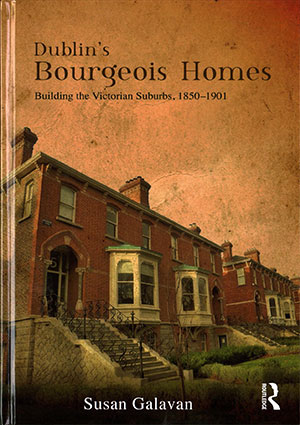Dublin’s bourgeois homes: building the Victoriansuburbs, 1850–1901
Published in Book Reviews, Book Reviews, Issue 6 (November/December 2017), Reviews, Volume 25SUSAN GALAVAN
Routledge
£95
ISBN 9781472471727
Reviewed by Ellen Rowley
Ellen Rowley lectures in the School of Architecture, University College Dublin.

Dublin’s bourgeoishomes by architect-turned-historian Susan Galavan manages to bring something new and important to the already packed bookshelves on Dublin history. Because architecture, and specifically the more everyday architecture of housing, is the language with which Galavan is most familiar, the book seems somehow different: different in its lucidity, different in its straightforwardness. Aside from the clear writing, the book’s subject is focused without being myopic. Moreover, it is persuasively organised. A series of well-known but not well-understood Victorian Dublin neighbourhoods and residential streets are analysed according to their architectonics, their social histories or domestic lives, their materials, their developers and their economic geographies. This five-part division, along with a fluid contextualising introduction and a reiterative conclusion, points to the books’sorigin as a Ph.D thesis, in this case a rigorously researched and conscientiouslysupervised thesis. And in its reformulation as a monograph, the text retains its Ph.D rigour but now, arguably, has restraint.
Motivated by yet another lacuna in Irish architectural historiography—the physical presence of this Victorian housing, against its lack of attention from historians—Galavan points to a series of historic happenings, from peripheral location to Irish neutrality in the Second World War, which contributed to this housing stock’s preservation in the city. Its significance, then, comes in part from its uncanny survival. Additionally, Galavan describes how these new homes for Dublin’s rising middle class provide a lens through which the social and technological shifts of the second half of the nineteenth century are magnified,and this pairing of built evidence and socio-cultural reading is upheldthroughout the book.
What sets this urban history apart is that the starting and end points are always the built evidence. As recent offerings—from rural and revolutionary atlases to cultural geographies and urban history overviews—attest,the spatial consequences or origins of Irish historical events are compelling,but the visual illiteracy of these histories often weakens and undermines their premise. Contemporary written sources are not enough for this type of ‘new’ spatialising history. Tramping the streets, analysing the sites, looking and sketching all bring the spatial history to a different level. With Galavan’s architectural history, we encounter a rare beast that does such object-led analysis—good old-fashioned art history—while also interrogating the object beyond itself, contextually. She has closely read the leading secondary texts by Christine Casey, David Dickson and Mary E. Daly, to which she brings unsurprising readings of the Dublin Builder and Maurice Craig, for instance. And in typical architect fashion, she attempts to philosophise through her somewhat perfunctory consideration of Aldo Rossi’s 1960s seminal Architecture of the city—the city is defined more by its houses than by its cathedrals. Nevertheless, taken together, along with analysis of original drawings and of quantity surveyor files, these old and newer sources contribute to a study that is balanced and expansive. Most particularly, Galavan’s exploration of the building of Dublin’s Victorian suburbs (1850–1901) is a fascinating history of social class.
The book’s closest examination of class is Chapter 2’s ‘The Domestic Realm’. Here the psychology of domesticity is suggested, while three house plans, from 1851, 1880 and 1900, are surveyed, bringing us from prime Victorian aspirations to emerging Edwardian priorities. The technologies of living confrontanalysis of server and served and the relationships between adult and child, female and male. Quite amazing yet fundamental changes include the incorporation of indoor bathrooms between the 1850s and the 1880s, signalling massive changes in Dublin’s water and sewerage infrastructure(s), as well as the democratisation of domestic staff accommodation. Often resorting to colourful London commentaries (the legendary Diary of a nobody or Morris’sA house for the suburbs (1860) and Kerr’s A gentleman’s house (1864)), Galavan tries to enliven the fairly mundane room-by-room description, but unfortunately the text is unbroken by visual spice or any photography/drawings in this chapter.
In the end, Chapter 4’s overview of three speculators, Michael Meade, William Carvill and John Crosthwaite, provides the most penetrating portrait of Victorian Dublin. Opening the discussion outward to the wider processes of colonising new ‘genteel’ suburbs, Galavan’s account of the developments by these three pointedly Catholic men explores shifts in religious power and uncovers how the enduring legacies of Dublin’s property wealth began. With Crosthwaite developing much of the Kingstown township and Carvill building swathes of Rathgar, Meade created the largest building company in Dublin and built himself a remarkable Italianate villa on Ailesbury Road. The chapter shows how these areas (Ballsbridge, Rathgar/Rathmines and towards Dún Laoghaire) became, to paraphrase Galavan, breeding grounds of social exclusivity. Interestingly, a hitherto-unknown type emerges: the Catholic businessman, immersed in local politics, national industries and transatlantic trading. Clearly Dublin’s commercial class moved past the petit bourgeois cliché, and by the mid-1860s all three speculators were engaged in a significant municipal building boom.
Galavan’s(and Routledge’s) presentation of these histories is mediated through portraits and other illustrations. Generally, though, outside of the colour plates of rare drawings from the Murray Collection (Irish Architectural Archive), the book is pretty light in terms of visual material. Galavan’s own architectural drawings (floorplans) illuminate, while her photography reinforces the houses’ familiarity. Through analysis, we learn how eighteenth-century Dublin townhouse preferences for first-floor (piano nobile) living moved downstairs to the ground/reception floor. The familiar becomes extraordinary. Descriptions of materials and stone-quarrying, along with readings of brilliant masters and doctoral research (such as Eve McAulay’s Ph.D on the Pembroke Estate), give the reader access to highly specialised knowledge.
Will the book interest those outside Ireland? At the very least, it throws fresh light on Dublin’s evolution as an important city within the British Empire.
















